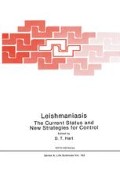Abstract
The appearance of specific clinical types of American cutaneous leishmaniasis depends on host genetic factors and the virulence of the parasite. Bradley et al (1979), showed, in mice, that resistance to Leishmania donovani is controlled by autosomic gene localized on chromosome 1, designed at Lsh gene. This gene also controls resistance to Salmonella typhimurium, Mycobacteirum bovis and Mycobacterium lepraemurium in mice. It seems that this gene does not have any effect in Leishmani major and Leishmania mexicana infections. Susceptibility to Leishmania major is controlled by the Scl gene which is found on chromosome 8. It also influences infection by Leishmania mexicana.
Preview
Unable to display preview. Download preview PDF.
References
Bradley, D.J., Taylor, B.B., Blackwell, J.M. and Freeman, E.P., 1979, Regulation of Leishmania population within the host. II mapping of locus controlling susceptibility to visceral leishmaniasis in the mouse. Clin. Exp. Immunol., 37:7
Grimaldi, G. Jr., Moriarty, P.L. and Hoff, R., 1980, Leishmania mexicana: immunology and histopatology in C3H mice. Exp. Parasitol., 50:45
Grimaldi, G. Jr., Soares, M.J and Moriarty, P.I., 1984, Tissue eosinophilia and Leishmania mexicana mexicana eosinophil interaction in murine cutaneous leishmaniasis., Parasite Immunol., 6: 397
Monroy, O., Ridley, D.S., Heather, C.J. and Ridley, M.J., 1980, Histological studies of the elimination of Leishmania enriettii from skin lesions in the guinea pig. Br. J. Exp. Path., 61: 601
Monroy, O.A. 1983, Aspectos histopatologicos relacionados con la respuesta inmun en dos tipos de leishmaniasis., cutanea americana. Tesis Doctoral. Escuela Nacional de Ciencias Biologicas, IPN. Mexico.
Pearson, N.D., and Steigbigel, R.T., 1981, Phagocytosis and killing of the Protozoon Leishmania donovani by human polymorpho-nuclear leukoctes., J. Immunol., 127: 1438
Perez, H., Arredondo, B. and Gonzalez, M. 1977, Comparative study of American cutaneous leishmaniasis in two strains of inbred mice., Infec. Imm., 22: 301
Perez, H., Labrador, F. and Torrealba, J.W., 1978, Variations in the response of five strains of mice to Leishmania mexicana., Int. J. Parasitol., 9: 27
Zeledon, R., Macoya, G., Ponce, Chaves, F., Murillo, J. and Bonilla, J.A., 1980, Cutaneous leishmaniasis in Honduras Central America., Trans Roy. Soc. Trop. Med. Hyg., 70: 276
Author information
Authors and Affiliations
Editor information
Editors and Affiliations
Rights and permissions
Copyright information
© 1989 Springer Science+Business Media New York
About this chapter
Cite this chapter
Monroy-Ostria, A., Velez-Castro, E., Monroy-Ostria, T. (1989). Histopathogenic Mechanisms in American Cutaneous Leishmaniasis of Mice. In: Hart, D.T. (eds) Leishmaniasis. NATO ASI Series, vol 171. Springer, Boston, MA. https://doi.org/10.1007/978-1-4613-1575-9_53
Download citation
DOI: https://doi.org/10.1007/978-1-4613-1575-9_53
Publisher Name: Springer, Boston, MA
Print ISBN: 978-1-4612-8862-6
Online ISBN: 978-1-4613-1575-9
eBook Packages: Springer Book Archive

